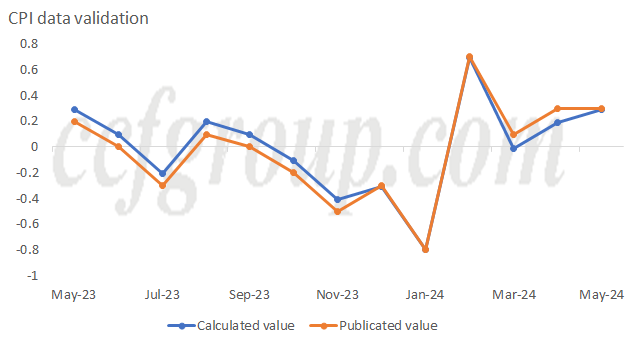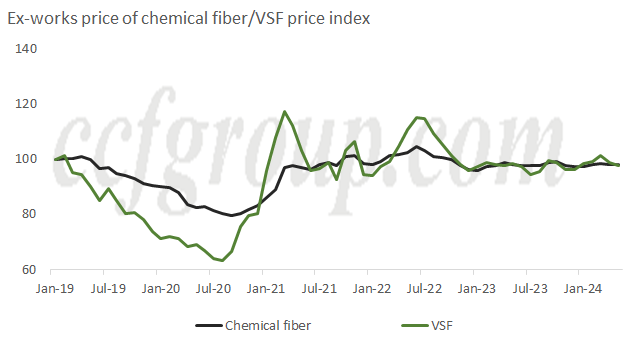Hypothesis on the price convergence of VSF
As our economic environment increasingly influences industries, there is growing attention to macroeconomic data. This focus on macro data is undoubtedly a good habit for researchers or decision-makers. But how to integrate macro data with micro-industries, even quantitatively analyze, is a question that needs addressing.
Wednesday marks the release of CPI and PPI by the National Bureau of Statistics, two fundamental indicators for macroeconomic beginners. We can easily access the public data showing a 0.3% year-on-year increase in CPI and a 1.4% year-on-year decrease in PPI for May.
If we stop at merely obtaining public information, this focus on macroeconomics is akin to a curiosity. A feasible approach is to further process this data.
First, we can focus on the more micro components of this data. The National Bureau of Statistics on its official website provides details on the composition of these two data sets, as shown in the figure below, from where we can see more specific industry data and then approach these numbers with a critical attitude.
| Major Data of Producer Price Index in May 2024 | |||
| Item | M-O-M change (%) | Y-O-Y change (%) | Jan-May y-o-y change (%) |
| 1. Ex-works prices of industrial producers | 0.2 | -1.4 | -2.4 |
| Production materials | 0.4 | -1.6 | -2.9 |
| Mining | 0.2 | -1.2 | -4.7 |
| Raw materials | 0.9 | 0.5 | -2 |
| Processing | 0.1 | -2.6 | -3.2 |
| Means of living | -0.1 | -0.8 | -0.9 |
| Food | -0.2 | -0.7 | -0.9 |
| Clothing | 0.1 | 0.4 | 0.3 |
| General daily necessities | 0 | 0 | 0 |
| Durable consumer goods | -0.3 | -1.8 | -1.9 |
| 2. Purchase prices of industrial producers | 0.3 | -1.7 | -3 |
| Fuel and power | 0.2 | -2.1 | -4.9 |
| Ferrous metal materials | 0.2 | -3.1 | -2.8 |
| Non-ferrous metal materials and wires | 3.6 | 8.1 | 2.8 |
| Chemical raw materials | 0.1 | -2.9 | -4.8 |
| Wood and paper pulp | 0.2 | -1.8 | -4.2 |
| Building materials and non-metals | -0.5 | -8.4 | -7.5 |
| Other industrial raw materials and semi-finished products | 0 | -1.5 | -1.8 |
| Agricultural and sideline products | -0.4 | -4.6 | -5.4 |
| Textile raw materials | -0.1 | 0.3 | 0.2 |
| 3. Ex-works prices of major industries | |||
| Coal mining and washing | 0.5 | -9 | -13.9 |
| Petroleum and natural gas mining industry | -2.1 | 9.4 | 6.5 |
| Ferrous metal mining industry | -0.1 | 4.6 | 8 |
| Nonferrous metal mining industry | 4.4 | 13.5 | 7.2 |
| Non-metallic mining industry | 0.2 | -2 | -2.1 |
| Agricultural and sideline food processing industry | -0.5 | -3.4 | -3.8 |
| Food manufacturing industry | -0.2 | -1.1 | -1 |
| Wine, beverage and refined tea manufacturing industry | -0.1 | -0.1 | 0.3 |
| Tobacco products industry | 0 | 1 | 0.8 |
| Textile industry | -0.1 | -0.6 | -0.8 |
| Textile clothing and apparel industry | 0.2 | 0.6 | 0.4 |
| Wood processing and wood, bamboo, rattan, palm and grass products industry | -0.2 | -1.3 | -1.1 |
| Paper and paper products industry | -0.7 | -3.9 | -4.8 |
| Printing and recording media reproduction industry | -0.1 | -2 | -1.1 |
| Petroleum, coal and other fuel processing industry | 1 | 3.4 | -2.3 |
| Chemical raw materials and chemical products manufacturing industry | 0.1 | -3.4 | -5.6 |
| Pharmaceutical manufacturing industry | -0.1 | -0.7 | -0.6 |
| Chemical fiber manufacturing industry | -0.2 | -0.3 | 0.4 |
| Rubber and plastic products industry | -0.2 | -2.4 | -2.7 |
| Non-metallic mineral products industry | -0.8 | -8.8 | -8.3 |
Taking the CPI numbers as an example, the Bureau also discloses month-on-month growth rates in the public data. According to mathematical principles, multiplying these month-on-month data cumulatively can yield continuous figures. Comparing these figures with the year-on-year data can help determine feasibility. Although the National Bureau of Statistics is currently China's most authoritative statistical department, faced with the vast market composed of 1.4 billion people, statistical results may still be subject to deviations. Therefore, it is advisable to compare these numbers through different calculation methods to enhance their credibility.

Afterward, search for indicators within these numbers that are more closely related to our own industries, examining the correlation of these indicators in numerical terms. Taking the example of the author's research on VSF, observation reveals a certain approximate positive correlation between the price changes of VSF and the producer price index (PPI) of chemical fibers, and prices exhibit a converging trend.
The following chart selects the month-on-month growth rate of chemical fibers in the PPI and the average price of VSF. The results are obtained after processing based on a comparison with January 2019 as the benchmark.

It can be preliminarily observed that from 2019 to the present, the price of VSF has basically maintained a similar trend to the statistical ex-works price of chemical fibers reported by the National Bureau of Statistics. Moreover, during the ups and downs, VSF exhibits greater elasticity. However, when prices tend to stabilize, the fluctuation amplitude of VSF will regress toward that of the ex-works price of chemical fibers. This assumption has obviously held true over the past five years. Whether it will continue to hold true in the future remains to be further observed.
After observing such changes, in the specific analysis and decision-making process, we can combine macroeconomic data with micro-industries. For example, when the ex-works price of chemical fibers under the PPI continues to rise and the policy still advocates anti-inflation, VSF may continue to show a rising trend. However, when the price of chemical fibers remains stable for a long time, and at this time, if VSF is still at a high level, attention should be paid to the risk of decline later.
Of course, there are many more micro-level determinants, not solely determined by a single macro factor. In practical operations, specific judgments need to be made by combining comprehensive factors.
- Top keywords
- Cotton Price
- Cotton Futures Price
- Cotton Futures
- CZCE
- PTA Futures Price
- Chemical Fiber
- Polyester Prices
- Wool price
- PTA Futures
- Shengze Silk
- China
- Yarn Price
- price
- China Textile City
- Fibre Price
- Benzene Price
- Cotton
- Index
- Cotton Index
- PTA
- fabric price
- NYMEX
- Top 10
- textile industry
- Spot Cotton
- Cotton Yarn
- Polyester Price
- Futures
- PTA Price
- cotton yarn price

